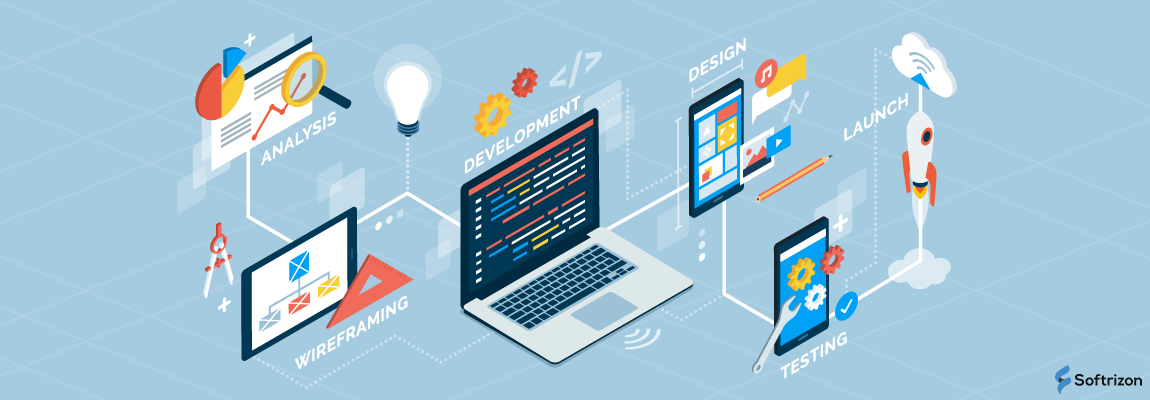It was not that long ago that mobile applications did not exist. It was not until 2007 that Apple debuted the first iPhone, which was solely responsible for the app ecosystem that we know today. Yes, every single app on your phone or tablet owes its existence to a dream that Steve Jobs had and was able to transform into reality. Now, the mobile application development process allows you to do something similar.
The State of the Mobile App Industry
Before we dive into the mobile app development process, we should look at the industry itself as a whole. How robust is it? Is it still a vital area of focus for business owners and decision-makers? Do consumers still demand new apps? To help answer some of those questions, consider the following statistics:
- We expect to hit 7 billion mobile users sometime in 2021
- Mobile apps were downloaded 218 billion times (that’s billion with a B)
- Consumers spent a combined $143 billion in global app stores in 2020
- 92% of a user’s time spent on a smartphone involves interacting with an app
Those are compelling statistics that illustrate several key points for anyone on the fence about mobile application development. Mobile apps are incredibly popular. That popularity is still growing. A mobile app will help you reach your audience, whether you have a B2B or B2C business.
How do you create an app, though? What’s the process to follow to take your idea and give it life? Actually, it just requires a few steps. We’ll explore those in this blog post.
Join other businesses to get the latest insights from Softrizon delivered right to your inbox.
1. Ideation and Strategy
The first step in the mobile application development process is ideation and strategy development. This is where you will take your idea and begin evolving it with the goal of turning it into an application that offers value to users and is capable of living on their mobile devices. However, there are some pretty specific things that must be accomplished during this phase.
First, you need to identify the users you have in mind. Will the app be designed for your employees? For consumers in general? For a specific subset of consumers? For business owners?
What features and functions should the app offer? What problems does it solve, or what does it let users accomplish? In short, what’s the value of the app to your audience? This should be clearly communicated and capable of being encapsulated in just a sentence or two.
What is the competition like? Today, most applications are not all that novel. There will be at least one other app that does something similar, if not the same thing.
What are your goals with the application? Do you want to simply solve problems? Do you want to drive traffic to another online destination? Are you building brand recognition? Are you attempting to drive profits?
What platform will your application live on? Do you need to hire an iOS or Android app developer, or do you want to pursue a hybrid app?
Keep in mind that the average mobile application can cost up to $200,000 to develop and will take up to six months to complete. Bake this understanding and the answers to the questions above into your app development strategy.
2. Planning
After answering the questions in the step above, it’s time to begin using that information to inform your plan. You should be able to start to see the final shape of the app starting to take form. Now is the time to chart the course toward that final vision.
The first thing to do here is to create an app development roadmap. Set key deliverables and progress stages and peg them to features, functionality, and KPIs that matter to your organization. Set delivery milestones for different elements of app development.
This is also the time to start identifying development talent. Are you going to pursue in-house app development? Do you have the talent for that? Most organizations do not, so they turn to outsourced app development companies instead. At Softrizon, we offer full mobile application development solutions capable of meeting any need.
3. Design
Once you have your development team in place and a plan to guide development toward your goals, it’s time to move on to the design phase. In most situations, this phase and the next are combined into design/development, as they are inextricably linked. However, we’ll treat them as separate steps for the sake of clarity.
The design includes a broad range of sub-steps, such as creating a wireframe or prototype of the app. This should begin with the basics, such as desired features and functions, as well as screen flow and overall user experience. You’ll need to flesh out how you want users to interact with the app, which screens should display at which steps, and more.
Once you’ve got the functionality aspect nailed down, it’s time to think about aesthetics. While treated separately, it’s an integral part of the user experience. Think about your user interface, the colors chosen, the graphics used, and how everything combines to create the experience your users will enjoy within the application. You should also think about how the app’s aesthetics tie into your brand identity.
4. Development
As mentioned, development is part and parcel of the design process in most cases. This is where the rubber meets the road, so to speak, and the app developer begins to flesh out the app. There are many steps in this process, and they can include defining the app’s technical architecture, choosing a technology stack that you’ll use, defining development milestones, and more.
There are three specific areas of concern for most mobile apps when it comes to development: frontend development, backend development, and the API (or Application Programming Interface). Front-end development is creating the elements that your users will interact with when they open and navigate through the app. Backend development is necessary to support user actions and provide functionality while also providing data storage. The API is the middleman and acts as a go-between for front and backends.
5. Testing
In some forms of app development, testing is a separate stage. However, with an Agile app developer, it’s baked into the design and development process to save time and prevent needless revisions and double-work. In this process, every function and feature is tested as it is developed, then again as new ones are added. This helps to avoid unexpected interactions and bugs.
However, testing must also involve several end-users. Both alpha and beta testing should involve real people outside the app development team to gain meaningful insight into features, functions, aesthetics, use flow, and other vital metrics. Think of this more as quality assurance than bug testing, although testers will also report bugs and other incorrect operations so that the app developer can address those promptly.
6. Launch and Maintenance
Finally, we have an app launch followed by maintenance. This is the day you’ve long awaited – the time when your app will finally be ready for primetime and take its place in the app store(s). your launch may be accompanied by little fanfare depending on your goals. Still, if you’re going with a consumer-facing app, the launch should be accompanied by announcements and a robust marketing campaign to let your audience know what you have to offer and what it can do for them.
Getting your app into Google Play and the Apple App Store will require specific steps, too. Most importantly, your app will need to meet app store requirements, so ensure that your app development team understands those.
Once the app is live, development does not stop. It simply transforms. Maintenance is critical – bugs will continue to crop up and must be addressed. You will also need to roll out updates and upgrades to the app over time. Make sure that your development team has a maintenance strategy in place that covers everything from remedying missed bugs to rolling out new versions of the app over time.
App Development Outsourcing or In-House Development?
One of the most crucial questions to answer in this entire process is whether you will develop your app using an in-house team or if you will take advantage of app development outsourcing options. For many businesses, outsourcing the app development process is the most effective option simply because they lack the in-house talent required. Building an app development team would not be a wise business decision.
Whether you need to fill key roles within your in-house app development team or you need full app development services from an outside source, we can help. At Softrizon, we work with small and medium-sized businesses to create mobile apps that help connect with and engage your audience, foster growth, and drive profitability. We invite you to contact us today to schedule your no-cost consultation and learn more about our mobile application development services and capabilities.




